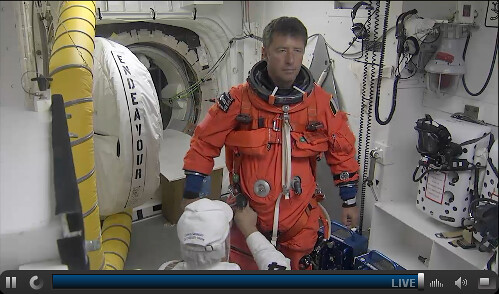The unplanned break-down of a Russian oxygen (O2) generator on the International Space station means that ATV’s cargo supplies of ‘fresh air’ – O2 – are now more important than ever.
The ‘BZh Liquid Unit’ of the Russian ‘Elektron’ oxygen generator was declared failed on 11 May (after lasting about three times longer than planned – so no one’s complaining). The system uses electrolysis to strip oxygen and hydrogen from water and the liquid unit is a central, essential part of the generator.
ESA astro Roberto Vittori preparing for ingress to Shuttle Endeavour for today’s launch from Kennedy Space Center. Photo via NASA TV
Russia will send a replacement unit to ISS on the Progress 43P unmanned freighter on 26 June, and there is a spare unit on board – but it suffers from a number of technical issues. As a result, and until the replacement unit is launched, the six-person ISS crew will require about 200 crew-days’ worth of oxygen – and this has to come from other sources.
“This means that the oxygen in the tanks of ATV Johannes Kepler – some of which has been transferred to the ISS several times previously during the current docked mission – has now become even more important. ATV is pretty useful in this type of situation,” says Nico Dettmann, Head of ESA’s ATV programme.
On Saturday, the crew initiated a refresh of the ISS cabin air for two hours with O2 from ATV.
“ATV is really an essential vehicle in terms of cargo delivery: fuel, oxygen and other important supplies. The cargo complement can be tailored differently for each mission according to the actual needs of the station. ATV2 is, for example, not carrying any water during this mission. Instead it is carrying a full complement of fuel. ATV3, on the other hand, will carry less fuel, but will carry water,” said Charlotte Beskow, Deputy Head of ESA’s ATV programme.
Granted, the situation is nowhere near critical and, yes, Space Shuttle Endeavour will provide oxygen once it docks shortly after today’s planned Shuttle launch – and there is still oxygen for approximately two weeks in the Progress 42P now attached.
“Elektron is basically out of order until the replacement unit arrives on 43P. The Shuttle will provide O2 when it’s docked, and 42P has about two weeks of O2, but there is nothing much else that can be relied upon except the crew’s Solid Fuel Oxygen Generator (SMOG) ‘candles’. So ATV with its 230 days of O2 is pretty essential for the next while,” says ESA’s Bob Chesson, Head of the ISS Mission Operations team.
The SMOG candles are kept on board for special situations and possible emergencies. These are candle-shaped devices that produce oxygen by chemical reaction and, if needed, one candle per person per day is sufficient. In fact, the supply of old candles currently onboard the ISS Must be used up before their end of life, within this year, so they may also be used to add oxygen to the ISS air.
All in all, ATV is once again proving its value in space.


 Automated Transfer Vehicle page
Automated Transfer Vehicle page ATV blog archive
ATV blog archive
Discussion: no comments